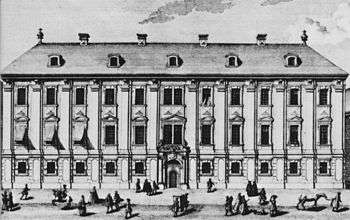Symphony No. 7 (Haydn)

The Symphony No. 7 in C major, Hoboken I/7, is a symphony by Joseph Haydn, sometimes called "Le midi", meaning "The Noon." The symphony was most likely composed in 1761, together with the other two of the Day Trilogy, Nos. 6 and 8.[1]
It is scored for 2 flutes, 2 oboes, bassoon, 2 horns, strings and continuo,[2] and exhibits many concertante features; indeed, the principal players of each of the string sections have solos, while the winds are given fairly difficult parts.[3] The work is in four movements:
Unlike the sunrise of Le matin, the slow introduction to the opening movement here is a ceremonial march.[4]
The first movement begins with a fanfare style, ten bar passage in C major, followed by the allegro part of the movement in D major. The second andante movement begins with an extended "recitative" in C major featuring a solo violin. The Andante follows in G major with solo violin and solo cello with prominent obbligato flute parts coloring the accompanying orchestration. The movement ends with an extended cadenza for the solo violin and cello.[4]
As is the case with symphonies 6 and 8, the double bass has an extensive solo in the trio of the menuet. Like the previous symphony, the finale contains passages for almost all the instruments, but here its intensified even more with solos and tuttis often exchanging every other bar. The recapitulation is notably accentuated with horn fanfares.[4]
References
- ↑ Antony Hodgson, The Music of Joseph Haydn: The Symphonies. London: The Tantivy Press (1976): 52. "The first three symphonies to be composed for the Prince were almost certainly the "Morning," "Noon" and "Evening" trilogy."
- ↑ H. C. Robbins Landon, The Symphonies of Joseph Haydn. London: Universal Edition & Rockliff (1955): 626. "2 fl., 2 ob., 1 fag., 2 cor., vln. I concertante, vln. II concertante, vcl. concertante, violone (cb.) solo, str., 'Basso Continuo' (i.e. cembalo)"
- ↑ Hodgson, 1976: 52.
- 1 2 3 A. Peter Brown, The Symphonic Repertoire (Volume 2). Bloomington and London: Indiana University Press (2002) (ISBN 025333487X), pp. 72–75.